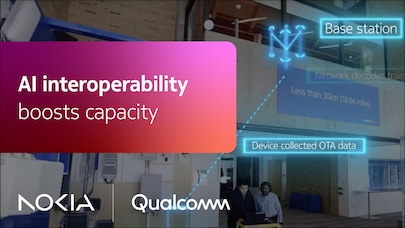Network solutions
Delivering trusted performance, built on truly open architectures
Experience networks with superior performance and security, designed to ensure operational resiliency.
Offered with modularity based on open standards to integrate with existing assets, and automation to reduce operational complexity and create more value.
Featured topics

6G networks will seamlessly blend virtual and physical realities, enabling humans to intuitively move between the digital, physical, and human worlds.

Discover how Nokia is harnessing the power of quantum technologies to revolutionize communication, security, and computation. Explore the future of networking with Nokia.

Build AI-powered networks that meet the demands of AI applications.

Simplify and transform the way you build, control and operate your network.
Explore our solution areas
At Nokia, we are a global leader in network solutions, offering a comprehensive portfolio of products and services across various areas. Our network solutions are designed to help businesses and organizations connect, communicate, and innovate in a rapidly evolving digital world, empowering them to achieve their full potential.

Cloud and network services
Get the right networking hardware and software to grow and transform your business.

Mobile networks
Scalable coverage and capacity.

Network infrastructure
Nokia offers high-performance data center, IP/MPLS, Optical and Fixed Network Infrastructure that help connect, secure and prepare networks for the future.
Autonomous Networks
Scale intent-based operations and services with AIOps.
Core networks
Differentiate your business and explore new opportunities
Private networks
Empowering enterprises to drive efficiency, security, reliability and sustainability.
Programmable networks
Enter the world of programmable networks.
Radio access networks
Scalable coverage and capacity.
Microwave transport
Advance 5G and critical connectivity with high-performance, reliable, green and cost-efficient microwave transport
RAN operations
Go beyond automation with machine learning.
Network efficiency
We help our customers optimize networks to maximize the business value of the entire network lifecycle and achieve the best performance to cost ratio.
Future-proof networks
Realize your digital transformation strategy, address ESG targets with open, software-driven networks and operations for building value and market share
Zero-emission mobile networks
Maximize energy efficiency with the lowest TCO, reduce embodied emissions and monetize mobile network backup batteries in energy and power reserve markets.
Data center networks
Realize the full value of AI with data center networking solutions that meet the connectivity demands of AI and traditional application workloads.
IP networks
Build scalable, secure, and adaptive networks
Fixed networks
Create a future-proof broadband network that connects more people, more quickly, and more profitably than ever before.
Optical networks
Scale made simple.
Featured insights
Upcoming events
Latest news
14 Jul 2025
17 Jun 2025
2 May 2025
9 Apr 2025
3 Apr 2025
31 Mar 2025
20 Mar 2025
17 Mar 2025

Training
Nokia's industry-recognized certification programs build your technical expertise and enhance your professional standing.


























